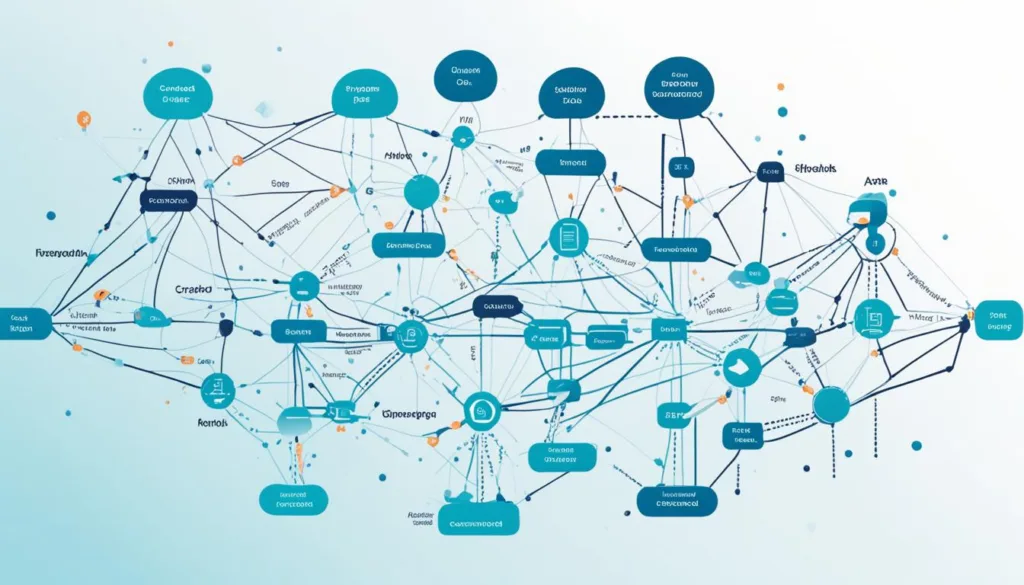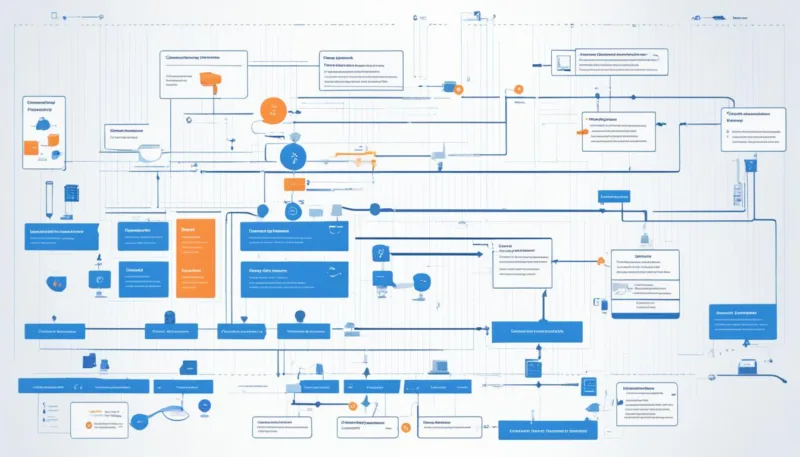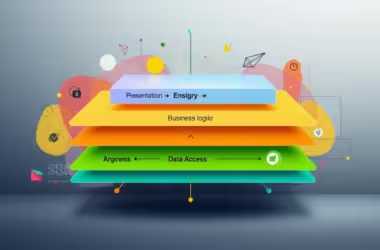At the forefront of contemporary software design patterns, Event-Driven Architecture (EDA) is revolutionizing how enterprise IT systems manage and process real-time data. By embracing asynchronous communication, EDA breaks down complex processes into discrete events that are handled as they occur, thereby displacing conventional request-response paradigms. This innovative approach facilitates decoupled systems that can respond with agility and precision, offering a transformative edge in today’s fast-paced business environment.
Seamless integration and fluidity of information are the hallmarks of an EDA-centric system in the enterprise sphere. By utilizing an event broker to mediate between applications, EDA ensures that event details are communicated swiftly and efficiently, without the sender or receiver bearing the burden of managing these connections. The elegance of this model lies in its simplicity and adaptiveness, allowing systems to interoperate within a dynamic landscape without being tethered by its complexities.
Key Takeaways
- EDA allows for the modularization of complex enterprise IT systems.
- Asynchronous communication is central to the responsiveness of EDA.
- Real-time data is managed more efficiently, improving operational agility.
- The event broker is key to decoupling systems within the EDA framework.
- EDA addresses the need for immediate, event-led interaction in business processes.
Understanding the Fundamentals of Event-Driven Architecture
Event-Driven Architecture (EDA) marks a transformative approach to software design, characterized by its inherent flexibility and adaptability in handling modern enterprise demands. Central to EDA are its core tenets that revolve around asynchronous event publishing and event subscription, enabling an ecosystem where decoupled applications can interact without direct dependencies. This model elegantly responds to state changes in a business environment, empowering real-time decision-making and operational excellence.
Definition and Core Principles of Event-Driven Architecture
The essence of EDA lies in its ability to manage the flow of information based on events that represent significant state changes. By capitalizing on the decoupled nature of asynchronous systems, EDA prioritizes events over static data, ensuring that systems react to the ebb and flow of business processes.
The Role of Event Brokers in Decoupling Applications
Event brokers serve as impartial conduits in the architecture, facilitating a neutral ground where applications exchange information. By abstracting the complexity of event subscription and distribution, event brokers uphold the philosophy of decoupled systems, allowing scalability and resilience.
How Events are Identified and Handled within EDA
Within the EDA ecosystem, events are meticulously identified through their significance in reflecting state transitions. The robust mechanism of asynchronous event publishing allows these events to be conveyed across different components of an application, fostering a proactive and dynamic response system.
| Component | Function | Impact on EDA |
|---|---|---|
| Event Publisher | Generates events related to state changes. | Initiates the asynchronous communication cycle. |
| Event Broker | Channels events between publishers and subscribers. | Enables a decoupled and scalable architecture. |
| Event Subscriber | Acts on the received events. | Drives real-time response to changing business conditions. |
The Advantages of Adopting Event-Driven Architecture
In the fast-paced digital economy, the adoption of Event-Driven Architecture (EDA) stands as a transformative move for businesses aiming to enhance their operational models with real-time responses and scalability of services. By reorienting system designs to be event-centric, companies unlock a suite of benefits that drive business agility and foster customer delight.
Enhanced Responsiveness and Real-Time Data Distribution
With EDA, the latency between an event occurrence and system response is minimized, enabling businesses to interact with customers and internal processes as events unfold. This immediacy of action creates a fluid, real-time experience for users, thereby enhancing customer satisfaction.
Scalability and Flexibility Benefits of Event-Driven Architecture
EDA exemplifies the principle of “scaling with ease.” Services can be independently developed and deployed, without necessitating comprehensive changes to the existing infrastructure. This scalability ensures that the businesses can grow and adapt while minimizing the need for system overhauls.
Impact on Business Agility and Customer Experience
Business agility is a critical asset in today’s competitive markets, and EDA serves as a key enabler. By allowing for rapid deployment of new functionalities and fostering a modular approach to service development, EDA positions businesses to efficiently address evolving market demands and enhance the customer experience.
Below is a table that illustrates how EDA can enable enhanced responsiveness and scalability, thus propelling business agility and customer delight:
| Feature | Benefit | Impact |
|---|---|---|
| Event Notification | Instantaneous data distribution | Time-sensitive decisions and actions |
| Decoupled Services | Independent scaling and maintenance | Continuous service delivery without disruptions |
| Dynamic Routing | Intelligent event processing and filtering | Targeted, efficient resource utilization |
| Modular Components | Flexibility in the development life cycle | Quick adaptation to changing customer needs |
Clearly, event-driven systems are more than just a technological trend; they represent a strategic approach for organizations aiming to adapt quickly to market shifts, scale their offerings, and consistently provide exceptional value to their customers.
Event-Driven Architecture in Action: Real-World Use Cases
The dynamic capabilities of Event-Driven Architecture (EDA) have proven instrumental in various sectors, driving innovation and efficiency through application integration and the Internet of Things (IoT). These technological strategies are not just theoretical concepts; they are being implemented in diverse industries to tackle pressing challenges, facilitate data democratization, and leverage a microservices architecture for agility and scalability. Understanding how EDA translates into practical applications can provide valuable insights into its transformative impact.
Application Integration and Data Sharing Strategies
Application integration is a cornerstone of modern enterprise, enabling disparate systems to communicate effortlessly and share data in near real-time. EDA excels in this area by marshaling events from various applications and directing them where needed without the constraints of traditional, tightly-coupled systems. This agility ensures that the right data flows to the right place at the right time, facilitating an environment ripe for data democratization where information is accessible across the organizational spectrum.
IoT Device Connectivity and Event-Driven Microservices
The Internet of Things represents a vast network of connected devices that generate a continuous stream of data. By incorporating EDA, businesses can harness this data to glean actionable insights and respond to market shifts or operational discrepancies with unprecedented speed. Similarly, EDA’s symbiotic relationship with a microservices architecture permits discrete, loosely-coupled services to react to events autonomously, enhancing resilience and expediting deployment cycles.
| EDA Feature | Application Integration Benefit | IoT & Microservices Advantage |
|---|---|---|
| Real-Time Data Flow | Synchronized enterprise application ecosystem | Timely responses to sensor data for rapid analytics |
| Scalability | Effortlessly incorporates new applications | Seamless onboarding of numerous IoT devices |
| Decoupling | Enhances system independence, reducing complexity | Individual microservice updates without system-wide disruption |
| Data Accessibility | Promotes an open data culture, fostering innovation | Enables expansive data utilization for prescient decision-making |
In conclusion, EDA is not a mere conceptual framework but a strategic tool that is actively reshaping the technological landscape. From ensuring application integration has the fluidity to underpin modern commerce, to championing the efficiency of IoT and the pivotal modularity of microservices architecture, EDA is the force behind many contemporary digital success stories.
Strategies for Implementing Event-Driven Architecture
To successfully adopt an event-driven implementation, organizations must pivot to an event-first approach, prioritizing their design around the management and propagation of events. This shift in perspective ensures that events take precedence in the system’s operation, influencing the arrangement and interaction of all components within the architecture.
Adopting an Event-First Mindset
Fostering an event-first approach means that developers and architects must conceive applications where the definition, production, and reaction to events are central to the entire system. Such an approach leads to a proactive stance in handling business operations, allowing systems to act upon events as they unfold, rather than as a post-facto reaction.
Design Patterns for Successful Event-Driven Architecture
Utilizing established design patterns is a pivotal strategy for a robust event-driven architecture setup. These patterns not only provide a blueprint for building scalable and maintainable systems but also guide developers in orchestrating how individual components interact through events. By adhering to these patterns, systems gain the flexibility to seamlessly integrate new services through event subscriptions, leading to an evolutionary and resilient tech environment.
| Design Pattern | Advantages | Use-Cases |
|---|---|---|
| Event Notification | This pattern enhances real-time communication, enabling services to be alerted immediately when specific events occur. | Notification systems for user activities or real-time data updates. |
| Event-Carried State Transfer | Reduces the need for additional queries, as the event itself carries the necessary snapshot of data for consumers. | Systems where consumers require context or data related to the event occurrence. |
| Event Sourcing | Provides a comprehensive log of all changes, allowing systems to revert or replay events to recover states. | Systems where auditing or transaction history is crucial for business integrity. |
Event-Driven Architecture: Who is Embracing It?
As we delve deeper into the shift towards real-time business models, we see a surge in EDA adoption across diverse sectors. The transformative impact of Event-Driven Architecture (EDA) is becoming a cornerstone of digital transformation, with industry-wide implementation showcasing significant efficiency improvements and innovation leaps.
Overview of Industries and Companies Utilizing EDA
The breadth of industries embracing EDA is a testament to its flexibility and effectiveness. From manufacturing to retail, healthcare, and beyond, companies are turning to EDA for its unparalleled capability to process events and trigger actions in real-time. Such industry-wide implementation is not just a trend but a strategic enhancement to address the ever-growing demand for agility and responsive systems in modern business landscapes.
Success Stories and Transformations via Event-Driven Architecture
Accomplished multinationals are among the trailblazers in capitalizing on the benefits of EDA. HEINEKEN’s adoption resulted in a harmony of its application ecosystem, boosting operational productivity and responsiveness. This is mirrored by successes in retail, where Schwarz Group’s leap into EDA facilitates an exceptional shopping experience through data-centric customer interactions. Furthermore, RBC Capital Markets’ immense data handling capacity signifies how EDA tackles the complexities of the financial industry, proving EDA’s robustness in handling extensive volumes of information while ensuring security and compliance.
| Industry | Key Benefits of EDA | Leading Adapters |
|---|---|---|
| Beverage Production | Increased operational efficiency, Improved burst management | HEINEKEN |
| Retail | Omni-channel experience, Real-time customer service | Schwarz Group |
| Logistics | Real-time supply chain management, Enhanced logistics operations | Unilever |
| Aviation | Modernized air traffic control, Improved safety and efficiency | The Federal Aviation Administration |
| Finance | Handling of massive data volumes, Facilitation of real-time transactions | RBC Capital Markets |
The table illustrates the widespread EDA adoption and its tailored benefits across industries, showcasing digital transformation through ingenuity and strategic foresight. The narrative woven by these success stories positions EDA as a pivotal solution for businesses aspiring to navigate the complexities of the digital age with finesse and adaptability.
Mastering Key Technologies Behind Event-Driven Architecture
In the expansive field of software architecture, event-driven systems provide a robust method for responding to and processing a multitude of asynchronous events in real-time. The success of such systems hinges on the performance and capabilities of their underlying technologies. Among these, Apache Kafka and RabbitMQ stand out as powerful enablers, each playing a pivotal role in the implementation of event-driven architectures (EDAs).

Apache Kafka and RabbitMQ as Enablers of EDA
Apache Kafka, born out of the need to handle massive volumes of events, is widely known for its high-throughput capabilities. It allows organizations to process event streaming data efficiently, enabling businesses to gain instant insights and react promptly to any actionable business event. On the other side, RabbitMQ—recognized for its flexible messaging patterns—provides a reliable messaging system with features like message queuing and routing to ensure precise delivery of events.
Comparing Messaging Systems and Event Streaming Capabilities
When assessing event-driven architectures, it’s critical to evaluate the unique affordances of the technologies at your disposal. Apache Kafka prioritizes persistence and the flow of data through its distributed event streaming platform, ideal for scenarios demanding scalability and durability. RabbitMQ’s architecture excels with its guaranteed delivery and advanced message routing capabilities, suited for complex messaging patterns where exactness is required.
Deploying the right technology in the right scenario is a strategic decision that prevents bottlenecks and maximizes the efficiency of EDA systems. Kafka and RabbitMQ complement each other, and together, they form a formidable backbone for modern, resilient, and flexible architectures.
Overcoming the Challenges Associated with Event-Driven Architecture
Event-Driven Architecture (EDA) is renowned for its scalability and real-time data processing abilities, yet it’s not without its inherent EDA challenges. Tackling the system complexity and ensuring precise event processing are among the most prominent obstacles that developers and IT professionals must navigate. Accurate event processing is crucial for maintaining system integrity, whereas managing system complexity requires a sophisticated understanding of the architecture.
Understanding and addressing these challenges begin with recognizing some common patterns that contribute to the complexity:
- Orchestrating multiple event streams
- Ensuring event-driven services efficiently maintain their state
- Deciphering the nuances among different technologies to choose the right tools
The table below offers a comparative look at strategic approaches to handling EDA challenges:
| Challenge | Strategic Approach |
|---|---|
| Event Processing Complexity | Employ robust event processing engines and frameworks that can handle complex event patterns. |
| State Management Across Services | Integrate state stores that are tailored for distributed systems and allow for efficient state recovery. |
| Technology Selection | Conduct a thorough analysis of performance benchmarks and adaptability features of EDA tools to align with business needs. |
| Developer Knowledge Gap | Institute comprehensive training and professional development programs focused on EDA paradigms. |
| Monitoring and Debugging | Implement advanced monitoring tools to provide visibility and simplify debugging in distributed systems. |
By employing these strategies, teams can significantly mitigate the challenges of EDA and harness its full potential to fulfill business objectives.
When to Opt for Event-Driven Architecture
When considering the implementation of Event-Driven Architecture (EDA), it’s crucial to apply decision frameworks that carefully assess system requirements. These frameworks are instrumental in determining EDA suitability within an organization’s specific operational context. There are clear scenarios where EDA’s benefits, such as enhancing real-time responsiveness and providing seamless system scalability can be maximized.
For instance, asynchronous workflows that demand nimble and adaptable communication between distributed services are quintessential candidates. Complex event processing systems that must instantly react to and handle a multitude of disparate events also thrive under EDA. Also, in a microservices landscape where isolated services must converse efficiently without causing bottlenecks, EDA stands out for its robustness.
However, EDA may not always be the optimal choice, especially in situations where simplicity and synchronicity take precedence over flexibility and scalability. Applications with linear workflows or those operating under strict latency requirements may benefit more from traditional, synchronous systems. The key is to evaluate both the benefits and limitations EDA presents in alignment with strategic business objectives and technical necessities.
Leveraging decision frameworks aids in this evaluation, ensuring that system requirements are met and that the benefits of EDA suitability are well-utilized. The following table outlines scenarios where EDA’s advantages can either be leveraged or should be cautiously considered:
| Scenario | EDA Suitability | Considerations |
|---|---|---|
| Asynchronous Workflows | Highly Suitable | Facilitates decoupled systems and promotes agility |
| Real-Time Data Processing | Highly Suitable | Allows for immediate action and response to events |
| Complex Systems Integration | Highly Suitable | Reduces interdependency and improves maintainability |
| Simple Transactional Applications | Less Suitable | May not warrant the complexity EDA introduces |
| Strict Latency Control | Less Suitable | Possibly more efficiently handled by synchronous systems |
In summary, when evaluating whether to adopt Event-Driven Architecture, a balanced analysis based on strategic decision frameworks is vital. Understanding the system requirements and measuring potential EDA suitability against these criteria ensures that organizations can fully reap the rewards of a responsive, flexible, and scalable IT ecosystem.
Conclusion
Embracing Event-Driven Architecture (EDA) is an unequivocal stride toward fostering a nimble, responsive framework pivotal for today’s enterprise IT systems. The collective experiences of industry leaders who have incorporated EDA into their operations vividly demonstrate the transformative effect it has on businesses. These narratives are not just tales of success but are testaments to the architectural transformation that is taking root across diverse sectors. By integrating EDA, these trailblazers have unveiled a future where software development is no longer stagnant but thrives on adaption and anticipates the rapid shifts in the global business environment.
The value of EDA resides in its capacity to offer a structure that enables applications and systems to react and adapt in real-time. This dynamic approach is essential in a landscape where requirements fluctuate with remarkable velocity, demanding architectural agility that traditional methods cannot provide. Therefore, the future of software development is increasingly interwoven with EDA’s principles, projecting a scenario where businesses not only react to change but leverage it to deliver exceptional value and service to their customers.
For any entity contemplating the leap toward embracing EDA, the journey is one of strategic shifts in mindset and practices. The pivotal elements of successful adoption include comprehensive comprehension of the underlying technology and commitment to meticulous implementation. Navigating the initial complexities of introduction may seem daunting, yet the extensive benefits—enhanced operational efficiency, customer satisfaction, and market responsiveness—justify the endeavor. In conclusion, as the digital era evolves, EDA stands as a cornerstone for businesses aspiring to achieve a responsive, innovative, and efficient operational model. The promise of EDA is not just a well-architected system but a future-proof enterprise ready to thrive amidst the boundless possibilities of technological advancement.






